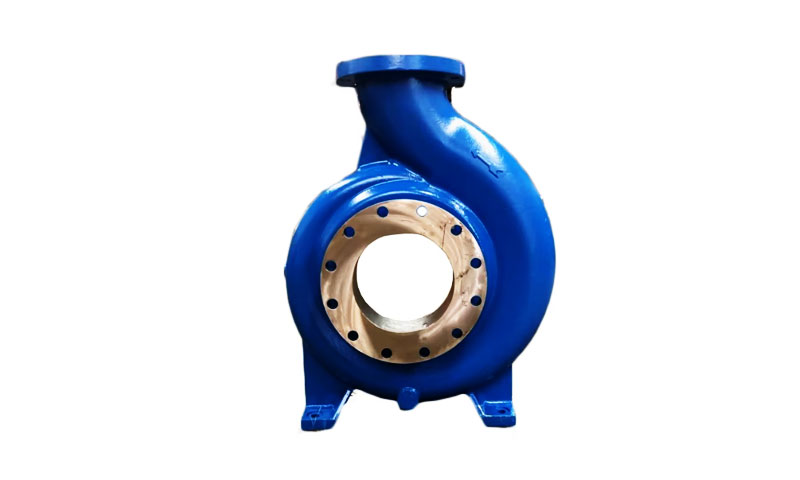1. Введение
Pump bodies are structural and hydraulic housings that convert driver energy into fluid motion. They commonly contain volutes, impeller seats, bearing bosses, flanges and internal passages.
The manufacturing route chosen for a pump body sets achievable geometry, металлургия, cost and lead time.
Investment casting stands out where geometry is complex (internal guide vanes, тонкие сети, integrated bosses), tolerances are tight, and high-integrity alloys (нержавеющие стали, никелевые сплавы, бронзы) требуются.
2. What Is an Investment Casting Pump Body?
Definition and core functionality
Анонца инвестиционный кастинг pump body is a pump housing produced by the lost-wax (инвестиции) метод кастинга.
A wax (или полимер) pattern of the pump body is created, coated in refractory ceramic to build a shell, the wax removed by heating, and molten metal poured into the ceramic mold.
The fired shell is broken away after solidification to reveal a near-net cast pump body that is subsequently finished and inspected.
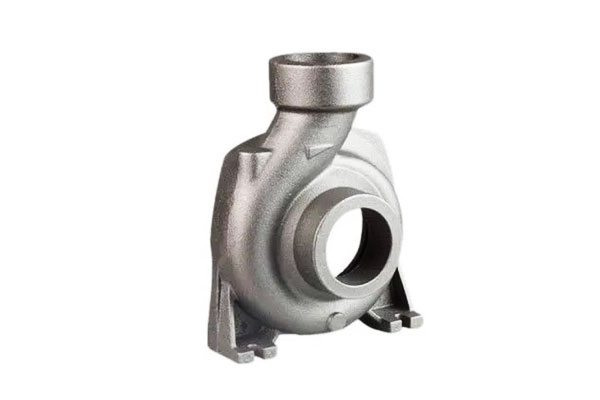
Typical specifications and dimensions
- Part mass: investment cast pump bodies usually range from a few hundred grams to tens of kilograms per piece; many foundries routinely cast pump bodies from ~0.5 kg up to ~50–100 kg depending on plant capability.
- Толщина стены: typical nominal walls for stainless or nickel alloys: 3–12 мм; minimum thin sections down to 1–2 мм are achievable in selected alloys and process control.
- Размерная толерантность (Ассоциация): general investment cast tolerances commonly fall in ± 0,1–0,5 мм for small features; percent-based tolerance of ±0.25–0.5% linear is a practical rule of thumb.
Critical machined features are usually left with machining allowance (0.2–2.0 mm depending on casting accuracy). - Поверхностная отделка (Ассоциация): typical Ra 1.6–3,2 мкм (50–125 мин) for standard ceramic shells; fine shells and careful pouring can produce Ra ≈ 0.8–1.6 μm.
Sealing faces or bearing journals are machined/lapped to much finer Ra (≤ 0.2 мкм) as required.
3. Соображения дизайна
Investment casting enables complex geometry, but good design practice maximizes quality and minimizes cost.
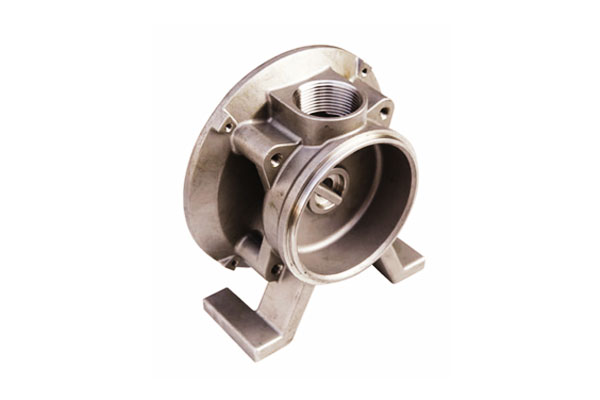
Hydraulic performance requirements
- Flow passages & volutes: smooth fillets and controlled convergence avoid separation and cavitation.
Internal fillet radii should be generous (≥ 1–2× wall thickness) to reduce turbulence. - Impeller seat alignment: concentricity and perpendicularity are critical — plan for machined bores and datum features.
- Clearances: pump clearances at impeller overhangs and seal faces must be maintainable by post-cast machining.
Structural requirements
- Stress & усталость: consider cyclical loads; use finite-element analysis to identify local stress risers.
Cast metallurgy (размер зерна, сегрегация) affects fatigue life—design to avoid thin, highly stressed bosses without proper filleting. - Vibration: stiff webs and ribs help raise natural frequencies; investment casting allows ribs to be integrated into the body.
Коррозия & носить
- Выбор материала: choose alloy based on fluid chemistry (pH, хлориды, эрозивные частицы, температура).
For seawater, duplex or cupronickel may be required; for acids, Hastelloy or appropriate nickel alloys. - Erosion resistance: smooth internal surfaces and sacrificial coatings (хардфакция, тепловой спрей) are options where particulate slurry is present.
Размерные допуски & поверхностная отделка
- Критические особенности: designate which faces/bores are finish-machined and specify machining allowances (НАПРИМЕР., 0.5–1.5 mm for sandier shells, 0.2–0.6 mm for precision shells).
- Sealing surfaces: specify Ra and flatness; often lapped/polished to Ra ≤ 0.2 μm and flatness within 0.01–0,05 мм depending on pressure class.
4. Materials for Investment Casting Pump Bodies
Material selection is a critical factor in designing and producing investment-cast pump bodies, as it directly affects mechanical performance, коррозионная стойкость, производство, и служба жизни.
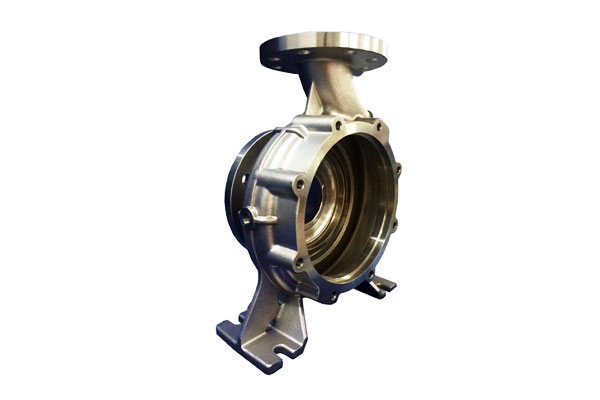
| Материальная категория | Примеры сплавов | Ключевые свойства | Типичные приложения | Соображения кастинга |
| Аустенитный Нержавеющая сталь | 304, 316Л | Отличная коррозионная стойкость, Умеренная сила, Хорошая сварка; Растяжение: 480–620 МПа, Урожай: 170–300 МПа, Удлинение: 40–60% | General chemical pumps, Очистка воды, еда & напиток | Good molten fluidity, low hot-cracking risk, easy post-machining |
| Дуплексная нержавеющая сталь | 2205, 2507 | Высокая сила (Yield 450–550 MPa), superior chloride stress corrosion resistance | Marine and offshore pumps, aggressive chemical environments | Requires controlled temperature; post-casting heat treatment to prevent sigma phase |
Никелевые сплавы |
Insonel 625, 718; Хастеллой | Исключительная коррозионная стойкость, Высокотемпературная сила, устойчивость к окислению | Химическая обработка, Производство электроэнергии, масло & газ | High melting points (≈1450–1600 °C); careful mold preheating and controlled pouring needed; difficult machining |
| Бронза and Copper Alloys | C93200, C95400 | Отличная устойчивость к коррозии морской воды, Хорошая износостойкость, antifouling; lower mechanical strength | Морские насосы, Охлаждение морской воды, Гидравлические компоненты | Lower melting points (≈1050–1150 °C) simplify casting; low thermal cracking risk; mechanical strength lower than stainless/nickel |
5. Investment Casting Process for Pump Bodies
Литье по выплавляемым моделям, также известен как Потерянный восковой кастинг, enables the production of pump bodies with complex geometries, тонкие стены, и высокая точность размеров.
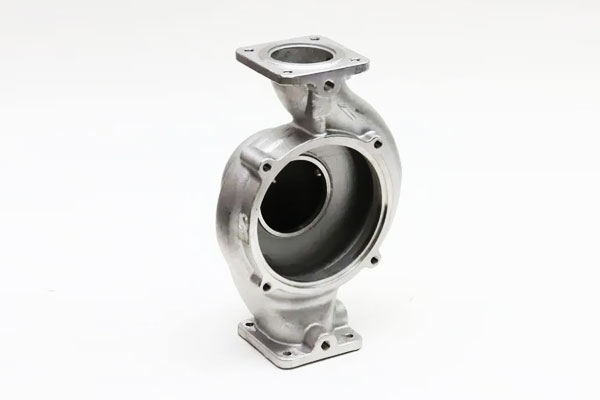
The process consists of several critical steps:
| Шаг | Описание | Ключевые соображения |
| 1. Создание воска | Molten wax is injected into precision molds to form replicas of the pump body. | Ensure uniform wall thickness; maintain dimensional accuracy ±0.1 mm; use high-quality wax to prevent distortion. |
| 2. Assembly of Wax Tree | Individual wax patterns are attached to a central wax sprue to form a tree for batch casting. | Sprue design affects metal flow; minimize turbulence during pouring. |
| 3. Керамическое здание снаряда | Repeated dipping in ceramic slurry and stuccoing with fine refractory sand creates a strong, теплостойкий раковина. | Target shell thickness (5–10 мм) depends on pump body size; avoid cracks and porosity in the shell. |
| 4. Dewaxing and Mold Firing | Wax is melted out (autoclave or kiln), оставив полость; the ceramic shell is then fired to remove residues and strengthen the mold. | Temperature ramping must be controlled to prevent shell cracking; residual wax must be fully removed. |
5. Заливка Металла |
Расплавленный металл (нержавеющая сталь, nickel alloy, или бронза) is poured into the preheated ceramic mold under gravity or vacuum-assisted conditions. | Pouring temperature and rate must ensure complete filling; control turbulence and prevent oxide formation. |
| 6. Затвердевание и охлаждение | Metal solidifies inside the mold; cooling rates affect microstructure, механические свойства, и остаточный стресс. | Thick sections may require controlled cooling to prevent porosity; thin walls must avoid hot tearing. |
| 7. Удаление снаряда | Ceramic shell is broken away mechanically, often using vibration, sand blasting, or chemical dissolution. | Avoid damaging intricate pump channels or flanges. |
| 8. Finishing and Cleaning | Residual ceramic, gating system, and surface imperfections are removed via grinding, выстрел в взрыв, or chemical cleaning. | Maintain dimensional tolerances; prepare surfaces for subsequent machining or coating. |
6. Пост-кассовые операции
After the pump body is removed from the ceramic shell, several post-casting operations are performed to ensure the component meets functional, размерный, и требования к качеству поверхности.
These operations are critical for high-performance applications in chemical, морской пехотинец, и промышленные сектора.
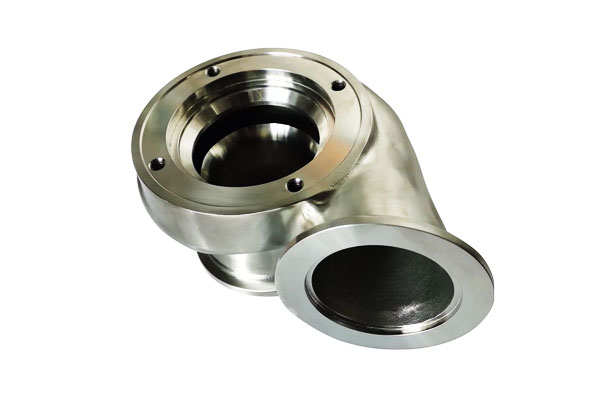
Термическая обработка
Термическая обработка is applied to relieve residual stresses, улучшить пластичность, and optimize mechanical properties:
- Снятие стресса отжиг: Heating to 550–650 °C for stainless steels reduces residual stress from casting and prevents distortion during machining.
- Решение отжиг: Applied for stainless steels and nickel alloys to homogenize microstructure and dissolve unwanted precipitates, ensuring corrosion resistance and consistent hardness.
- Aging or Precipitation Hardening (for certain alloys): Enhances strength and wear resistance in high-performance materials.
Обработка
Critical dimensions such as flanges, выросли, спаривающиеся поверхности, and threaded ports are machined to meet tight tolerances.
Typical machining operations include turning, фрезерование, бурение, and boring. Machining ensures:
- Dimensional tolerances of ±0.05–0.1 mm for precise assembly.
- Smooth sealing surfaces to prevent leaks in high-pressure applications.
Отделка поверхности
Поверхностная отделка Увеличивает коррозионную стойкость, износостойкость, и эстетика:
- Полировка: Improves smoothness for sealing faces and internal channels.
- Выстрел в взрыв: Removes residual ceramic particles and creates a uniform surface for coating or painting.
- Покрытия: Optional chemical or electroplated coatings (НАПРИМЕР., никель, PTFE) enhance corrosion resistance and reduce friction.
Неразрушающее тестирование (Непрерывный)
To detect defects such as porosity, трещины, или включения, NDT is performed:
- Рентгенография (Рентген): Identifies internal voids and inclusions.
- Ультразвуковое тестирование (UT): Detects subsurface flaws in thick sections.
- Краситель пенетрант тестирование (Пт): Reveals surface cracks and porosity.
Cleaning and Inspection
Окончательно, pump bodies are cleaned to remove residual machining oils, Обломки, or salts. Dimensional and visual inspections verify compliance with specifications before assembly or shipment.
7. Quality Assurance and Testing
Гарантия качества (QA) is critical in ensuring that investment casting pump bodies meet design specifications, performance standards, и отраслевые требования.
A systematic QA approach combines dimensional checks, Механическое тестирование, and non-destructive evaluation to detect defects and confirm functional integrity.
Проверка размерных
Dimensional verification ensures that the pump body conforms to design drawings and tolerances:
- Координировать измерительные машины (CMM): Measure complex geometries, выросли, фланцы, and mounting surfaces with accuracy of ±0.01–0.05 mm.
- Gauge Tools: Thread gauges, plug gauges, and height gauges verify critical features quickly in production.
- Измерение шероховатости поверхности: Confirms finishing requirements for sealing faces and internal channels (НАПРИМЕР., Ra ≤0.8 μm for hydraulic components).
Mechanical Property Verification
Mechanical testing validates that the material meets required strength, пластичность, и твердость:
- Тестирование на растяжение: Measures yield strength, Конечная прочность на растяжение, и удлинение, ensuring the material can withstand operational loads.
- Тест на твердость: Rockwell or Vickers testing confirms that heat treatment and material processing achieved the desired hardness.
- Ударный тестирование (Если требуется): Evaluates toughness for applications exposed to fluctuating loads or shock.
Неразрушающее тестирование (Непрерывный)
NDT techniques detect hidden defects without damaging the part:
- Рентгенография (X-ray/CT Scanning): Identifies internal porosity, включения, and voids, particularly in thick sections.
- Ультразвуковое тестирование (UT): Detects internal cracks, пустоты, or delaminations in dense materials like stainless steel and nickel alloys.
- Краситель пенетрант тестирование (Пт): Reveals surface cracks, выходы, or fine porosity not visible to the naked eye.
- Тестирование магнитных частиц (Гору): Applied for ferromagnetic alloys to detect surface and near-surface discontinuities.
Common Casting Defects and Mitigation Strategies
- Пористость: Minimized through proper gating, вентиляция, and controlled solidification rates.
- Усаживание полостей: Addressed via riser design and thermal management.
- Холодные отключения и ошибки: Avoided by maintaining optimal pouring temperatures and smooth flow in complex geometries.
- Surface Inclusions: Controlled by using high-purity alloys and proper degassing techniques.
8. Advantages of Investment Casting for Pump Bodies
- Сложная геометрия: внутренние отрывки, thin walls and integrated bosses with minimal secondary assembly.
- Форма в ближней сети: reduces material removal vs. rough machining from bar or billet — often 30–70% less machining для сложных частей.
- Высокая точность размеров & поверхностная отделка: less secondary finishing for many features compared with sand casting.
- Alloy flexibility: cast many stainless and nickel alloys with good metallurgical integrity.
- Small to medium production flexibility: tooling for wax patterns is relatively inexpensive vs. large die tooling, enabling economic runs from prototypes to thousands of parts.
9. Ограничения и проблемы
- Cost for very large parts: above certain sizes (часто >100 кг) investment casting becomes uneconomical compared with sand casting or fabricating/ welding.
- Время выполнения: pattern tooling, shell building and firing add lead time—prototype timelines usually measured in weeks.
- Porosity risk in thick sections: thick bosses or large cross-sections require careful gating, chills or segmenting to avoid shrinkage.
- Surface finish and tolerances depend on shell system: achieving ultra-fine finishes or extremely tight as-cast tolerances requires premium ceramic systems and process control.
10. Промышленные применения
Investment casting pump bodies are used across a broad spectrum of industries due to their complex geometry capabilities, материальная универсальность, и высокая точность размеров.
The process allows engineers to design optimized hydraulic passages, тонкие стены, and integrated mounting features that improve pump efficiency and longevity.
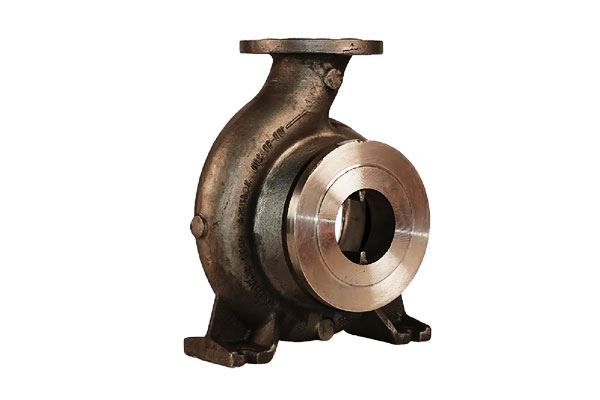
Chemical Processing Pumps
- Среда: Corrosive fluids such as acids, caustics, и растворители.
- Materials Used: Нержавеющие стали (316Л, дуплекс) and nickel alloys (Хастеллой, Insonel).
- Обоснование: Investment casting enables intricate internal channels, minimizing turbulence and ensuring uniform flow, critical for chemical process reliability.
Water and Wastewater Pumps
- Среда: High-volume pumping, abrasive suspended solids, and variable pH levels.
- Materials Used: Бронза, Дуплексная нержавеющая сталь, and corrosion-resistant cast irons.
- Обоснование: Thin-wall, smooth internal passages reduce clogging and energy losses, improving efficiency in municipal and industrial water systems.
Marine and Offshore Pumps
- Среда: Saltwater exposure, high-pressure operation, and cyclical mechanical stress.
- Materials Used: Медные сплавы (военно -морская латунь, бронза), Дуплексные нержавеющие стали.
- Обоснование: Resistance to corrosion and biofouling is critical; investment casting allows seamless, complex geometries to reduce maintenance and improve service life.
Масло & Gas and Power Generation Pumps
- Среда: Высокотемпературная, high-pressure fluids, and hydrocarbon-based media.
- Materials Used: High-nickel alloys (Insonel, Хастеллой), нержавеющая сталь, and cobalt-based alloys.
- Обоснование: Investment casting supports high-strength materials and precise tolerances necessary for critical applications such as turbine lubrication, chemical injection, and offshore drilling.
Specialty and Custom Pumps
- Среда: Laboratory, фармацевтический, or food processing applications requiring hygienic and precision performance.
- Materials Used: Нержавеющая сталь (304, 316Л), титан, или никелевые сплавы.
- Обоснование: Плавные поверхности, жесткие допуски, and complex geometries achieved by investment casting ensure minimal contamination risk and compliance with regulatory standards.
11. Сравнительный анализ
| Особенность / Критерии | Кастинг по выплавляемым моделям | Кастинг песка | Machining from Solid |
| Геометрическая сложность | Excellent – thin walls, внутренние каналы, intricate features achievable | Moderate – limited by core placement and mold stability | Limited – complex internal geometries often impossible without assembly |
| Точность размеров | High – ±0.1–0.25 mm typical | Moderate – ±0.5–1.0 mm | Very High – ±0.05 mm achievable |
| Поверхностная отделка (Раствор) | Fine – 1.6–3.2 μm typical; can be polished | Rough – 6–12 μm; requires machining for precision | Excellent – 0.8–1.6 μm achievable with finishing |
| Материальные варианты | Wide – stainless steels, никелевые сплавы, бронза, медные сплавы | Wide – iron, сталь, бронза, алюминий | Wide – depends on machinable stock availability |
| Размер партии | Low-to-medium – 1–1000+ parts | Medium-to-high – economical for large, Простые части | Low – material waste increases cost for large parts |
| Время выполнения | Moderate – wax pattern & shell building required | Short-to-moderate – mold preparation relatively quick | Variable – depends on machining complexity |
Материальные отходы |
Low – near-net shape reduces scrap | Moderate – gating and risers generate some waste | High – subtractive process creates chips and offcuts |
| Стоимость за часть | Moderate-to-high – tooling and process steps increase cost, economical for complex parts | Low-to-moderate – simpler molds, larger parts cheaper | High – extensive machining on large, complex parts is expensive |
| Сила & Честность | Excellent – dense microstructure, minimal porosity if controlled | Moderate – risk of sand-related inclusions and porosity | Excellent – homogeneous, Нет дефектов кастинга |
| Post-Processing Required | Often minimal – some machining, отделка | Usually significant – machining and finishing required | Minimal – final finishing for tight tolerances only |
| Типичные приложения | Pump bodies with thin walls, complex hydraulic channels, коррозионная стойкость | Большой, simple pump housings or structural components | Custom or prototype pump bodies requiring extreme precision |
12. Заключение
Investment casting pump body combines design freedom with metallurgical integrity, making them an excellent choice for many fluid-handling applications—especially where complex internal geometry, exotic alloys or tight tolerances are required.
Success depends on early design for casting, informed material selection, careful process control (залив, shelling, термическая обработка), and robust QA/NDT programs.
For critical pump systems—marine, chemical or power generation—investment casting can deliver reliable, economical components when specified and executed correctly.
Часто задаваемые вопросы
What maximum size of pump body can be investment cast?
Typical shop practice ranges up to ~50–100 kg per part, but the practical maximum depends on foundry capability and economics.
Very large pump bodies are more often produced by sand casting or fabricating/welding.
How much machining allowance should I design into an investment casting?
Позволять 0.2–2,0 мм depending on the criticality and shell precision. Specify tighter allowances only where the foundry guarantees precision shells.
Which material is best for seawater pump bodies?
Duplex stainless steels and selected copper-nickel alloys are common choices due to superior chloride pitting resistance and biofouling performance; final selection depends on temperature, velocity and erosion conditions.
What is the typical turnaround time for an investment-cast pump body?
Small production runs typically take 4–8 недель from pattern approval to finished parts; single prototypes can be faster with 3D-printed patterns but still require shell firing and melt schedules.
How do I specify acceptance criteria for porosity?
Use industry NDT standards (рентгенография, КТ, UT) and define acceptance levels in percent porosity by volume or via reference images.
Critical pressure-retaining pump bodies often require porosity <0.5% by volume and radiographic acceptance per customer standard.
